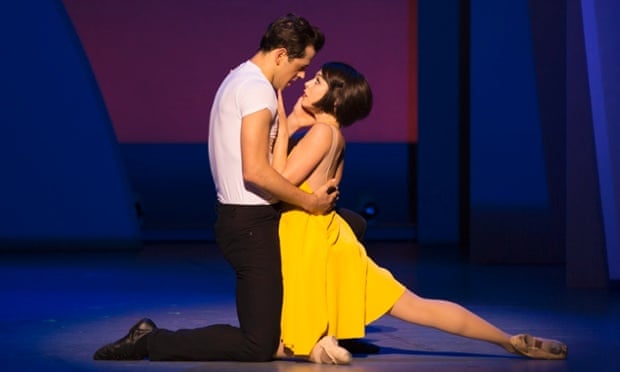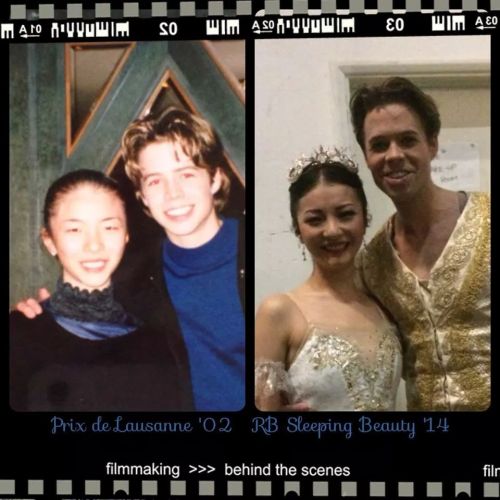Elena Gibson was a ballerina with the Canadian National ballet until an accident ended her career. The process of rehabilitation lead her to pole dancing. Now she is one of the world's leading pole dancers and has her own school in London. This short video tells her story. It also shows just how beautiful pole dancing can be. I love it!
Tuesday, 30 December 2014
Tuesday, 9 December 2014
An American in Paris, December 6th, 2014, Theatre de Chatelet
I'm not a fan of musicals, but if Christopher Wheeldon decides to direct one, I WILL get on the Eurostar to Paris to see it.
 An American in Paris is Wheeldon's first foray into the realm of musicals. The plot is based on the 1951 musical film, but the choreography is new. Wheeldon cast two ballet dancers (Leanne Cope, first artist of the Royal Ballet, and Robert Fairchild, principle dancer at New York City Ballet) in the lead roles.
An American in Paris is Wheeldon's first foray into the realm of musicals. The plot is based on the 1951 musical film, but the choreography is new. Wheeldon cast two ballet dancers (Leanne Cope, first artist of the Royal Ballet, and Robert Fairchild, principle dancer at New York City Ballet) in the lead roles.
The strength of this musical was always going to be in the ballet. In fact, the other elements are on the weak side. The plot is a standard love triangle set in post WW2 Paris. There's light humour and a gentle attempt at a deeper message about personal courage. The singing is so-so. The fake French accents are atrocious. (However, the fact that two ballet dancers, on top of being immensely talented dancers, can sing and act at all is pretty impressive.)
But the ballet element is beautiful. My favourite scene is when Lise auditions to be part of a ballet. She stands at the back of the room, performing the same steps as the other dancers, but gradually makes small changes until the steps are completely her own, and the audience is left without a doubt that she is a very special dancer. Her style is reminiscent of the Diaghilev era. In fact, the whole musical has a very stylish art deco feel to it.
Another great scene is the ballet within the ballet. In a feat of clever stage design, the backdrop - a red velvet curtain identical to the house curtain - opens to reveal conductor and audience within the ballet. We watch the audience watch the ballet.
The ballet within the ballet is Wheeldon doing what he does best. Personally, I would prefer if Wheeldon would stick to pure ballet - not because this musical wasn't good, but because Wheeldon is too good at making ballets to not make them! However, I'm guessing the people of Paris, who received An American in Paris with standing ovations, will not agree with me.
Sunday, 2 November 2014
World Ballet Day
If you missed the World Ballet Day live stream you can watch some of the highlights on Youtube. Here is a selection of videos. (If anyone finds the video of the San Francisco Ballet rehearsing William Forsyth please let me know - it was so good!)
Highlights from the Australian Ballet
The Bolshoi Ballet in full
The Royal Ballet
Highlights from the Canadian National Ballet
Highlights from the Canadian National Ballet
Insights: Ballet Evolved
A few months ago, I posted a video of the Royal Ballet's Insight series called "Ballet Evolved". Today, I got to attend the actual event in the Royal Opera House's Linbury Studio. The event comprised a lecture with demonstrations by members of the Royal Ballet, which helped to illustrate the points being made. The lecture was given by Ursula Hageli, a former ballerina and now ballet mistress with the Royal Ballet. She has been running the Ballet Evolved series for a few years now. She was also joined by Dr Giannandrea Poesic, a ballet historian and lecturer at the University of Bedfordshire.
 The theme of the lecture was the ballet class and how it evolved over the last four centuries. According to Hageli, the ballet class is the most important part of a dancers day: it is where dancers warm up, strengthen and generally prepare their bodies for all to come. Dancers attend class every day. As ballet itself evolved (more turnout, higher arabesques, more complicated spins, point shoes), class, too, evolved to ensure dancers were equipped with the necessary skills. For example, Marie Taglioni was the first ballerina to go en pointe, but this was before the invention of point shoes. Thus, this required an immense amount of ankle strength! (Interestingly, point work, though first introduced in France, really took off in Italy because it was where, thanks to the shoes makers Italy is generally so famous for, the point shoe was developed!)
The theme of the lecture was the ballet class and how it evolved over the last four centuries. According to Hageli, the ballet class is the most important part of a dancers day: it is where dancers warm up, strengthen and generally prepare their bodies for all to come. Dancers attend class every day. As ballet itself evolved (more turnout, higher arabesques, more complicated spins, point shoes), class, too, evolved to ensure dancers were equipped with the necessary skills. For example, Marie Taglioni was the first ballerina to go en pointe, but this was before the invention of point shoes. Thus, this required an immense amount of ankle strength! (Interestingly, point work, though first introduced in France, really took off in Italy because it was where, thanks to the shoes makers Italy is generally so famous for, the point shoe was developed!)
The evolution of ballet was demonstrated by dancers of the Royal Ballet, among them Gemma Pitchley-Gale, who was wearing bloomers under her knee length tutu - part of the 18th century ballet uniform, designed to maintain the ballerina's modesty by not revealing too much leg! Also, the lovely Fumi Kaneko, for whom today was the first time performing in front of an audience after returning from injury. And Marcelino Sambe, who, in addition to being a great dancer, is hilarious! It was really nice to get to see the dancers personalities come through!
Ballet Evolved was interesting, informative and entertaining ,and I shall definitely attend the next event! The event was filmed, and videos should be going up on Youtube soon. I will post them here when they become available.
Thursday, 30 October 2014
The Guardian: Will they make it to the Royal Ballet?
Just found this very interesting article about life at White Lodge, and more generally, the state of British ballet.
Monday, 6 October 2014
Discover Ballet: A day in the life of a ballerina
I never get bored of watching this video from the Royal Ballet archives of Yuhui Choe taking us through her day.
Friday, 3 October 2014
Insights: The Royal Ballet in Class
Today I got to watch members of the Royal Ballet in class! This open class was part of the Royal Opera House's Insights series, and there will be similar events occurring throughout the year. I think it's really wonderful how actively the Royal Opera House pursues audience outreach.
I went to the class expecting mostly members of the corps the ballet to be there and was completely blown away to see Sarah Lamb, Steven McRae, Thiago Soares, Federico Bonelli, Akane, Takada, Eric Underwood, Yuhui Choe, Ryoichi Hirano and Claire Calvert all there, sitting under the barres warming up! They were dressed in layers of tights, leggings, leg warmers and jumpers, surrounded by yoga mats, leg rollers and thera-bands, stretching and chatting amongst each other. It was so great to see how the dancers socialise with each other. The atmosphere felt pleasant.
It was really interesting seeing how ballet dancers start their day. The class was structured like a typical ballet class, starting at the barre and progressing to the centre. The dancers shed layers of clothing as the class progressed (it got pretty warm in the studio even for the audience), and the girls started in flat and changed into point shoes for the centre. All the key exercises were covered from plies and tendus, to pirouettes and jumps. The class was given by Olga Everinoff, who demonstrated the exercises and walked around the room giving corrections in a clear but kind manner. It was obvious from the way the dancers acknowledged her when they left the class that she is well liked.
We were told that after class, which lasts 75 minutes, the dancers go on to rehearsals. Class starts at 10.30 and rehearsals go on to 17.30 on performance nights or 18.30 when there is no performance. They do this six days a week. It's absolutely incredible.
Wednesday, 1 October 2014
World Ballet Day
 Happy World Ballet Day! The Royal Ballet, The Australian Ballet, Bolshoi Ballet, The National Ballet of Canada and San Francisco Ballet are streaming live to YouTube from their rehearsal studios for 24 hours! You can watch the live stream here:
Happy World Ballet Day! The Royal Ballet, The Australian Ballet, Bolshoi Ballet, The National Ballet of Canada and San Francisco Ballet are streaming live to YouTube from their rehearsal studios for 24 hours! You can watch the live stream here:https://www.youtube.com/watch?v=dsLCbeXaztg
Thursday, 4 September 2014
Taylor Swift - Shake It Off
I love Taylor Swift's "Shake it Off" video, not least because of the ballet scenes. Here are some out-takes.
Sunday, 15 June 2014
My Royal Ballet 2013/14 Season in Review
This season was the first time I managed to catch, in some form or another, every production of the Royal Ballet on the main stage, as well as a handful in the Linbury Studio Theatre. The discovery that it is actually possible to get reasonably priced tickets, as well as Live Cinema screenings and Sky Arts 2 made it possible. I loved every moment, and it's pretty hard to pick my favorites. Nevertheless, looking back over the year, there are certainly some productions that stand out in my memory.
My favorite full length production was without a doubt Christopher Wheeldon's The Winter's Tale. In fact, this season was the season I really discovered Christopher Wheeldon for myself. He has an incredible ability to make ballets that feel contemporary without distorting the art form beyond recognition.
I also really enjoyed Giselle and was lucky enough to catch two performances, one in house with Sarah Lamb and Steven McRae, the other at the cinema with Natalia Osipova and Carlos Acosta. Seeing the same production twice with different casts was a really insightful experience for me. But my favourite casting throughout the whole season has consistently been Sarah Lamb with Steven McRae.
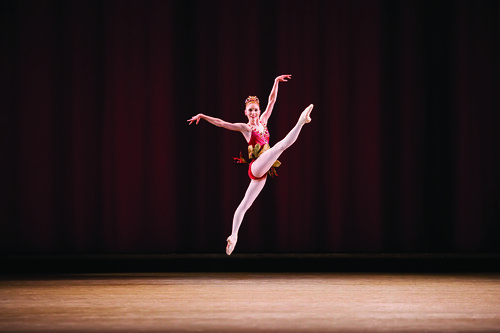 |
| Sarah Lamb in Jewels© ROH |
Over Christmas I saw both the Nutcracker and Jewels. I love the tradition of going to the ballet for Christmas, and both of these productions put me in a real Christmas spirit. (I'm quite sad the Royal Ballet won't be doing the Nutcracker next season!)
Triple Bills are always my favorite because one gets to see a variety of works. This season the Royal Ballet did four incredible triple bills. My top picks were
 |
| Melissa Hamilton and Gary Avis in DGV © ROH |
- the Rite of Spring, which 100 years on from it's world premier still feels ahead of its time;
- Steven McRae in Rhapsody - I will never forget those incredible jumps that made the entire audience gasp;
- Gloria, with the beautiful Melissa Hamilton;
- Serenade, which I'd actually seen performed by the Boston Ballet when they visited London last year, but loved even more this time;
- and Christopher Wheeldon's DGV - LOVED IT!!!
The biggest disappointment was probably Wayne McGregor's Tetractys. I loved everything he did up until then, especially Infra, Chroma and Raven Girl. But Tetractys felt a bit bland. Still, I was glad I got to see it after some shows had to be cancelled due to Natalia Osipova sustaining a concussion during a performance!
I always love going to the Linbury Studio because the productions tend to be more experimental. Liam Scarlett's Hansel and Gretel was definitely the most disturbing thing I saw at the Royal Ballet this season. Liam Scarlett has a really talent for telling dramatic stories through choreography. I am really looking forward to his new ballet, The Age of Anxiety, next season!
 |
| Northern Ballet dancers in Luminous Juncture Emma Kauldhar |
Other Linbury highlights included the Northern Ballet, especially Kenneth Tindall's Luminous Juncture, and Mayuri Boonham's The Human Edge, which she choreographed for Yuhui Choe and Kentra Kura. I also loved Draft Works, which I intend to make a regular fixture in my calendar!
Finally, an absolute highlight was getting to meet Edward Watson at a signing of his new DVD The Metamorphosis.
Saturday, 14 June 2014
Teen Vogue's Strictly Ballet
I love Teen Vogue's Strictly Ballet mini series about the School of American Ballet! It follows six students, aged 14-18, pursuing their dream to become professional ballet dancers.
Episode 1
You can watch other episodes here: http://video.teenvogue.com/series/strictly-ballet
Tuesday, 10 June 2014
Draft Works, ROH, June 4th 2014
Last week, I attended ROH's Draft Works for the first time. Draft Works is an evening of choreography by dancers of the Royal Ballet. It is annual event that has been happening regularly for a few years now.
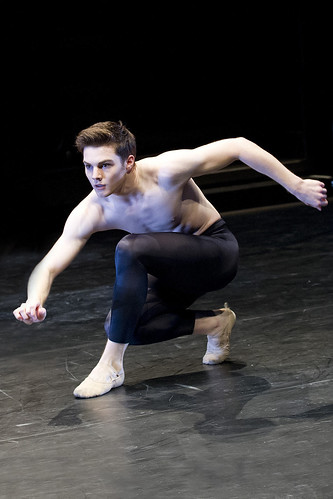 |
| David Donnelly in Aakash Odedra's 'Untitled', ROH/Tristram Kenton, 2014 |
 |
| Tara-Brigitte Bhavani and Romany Pajdak in Ludovic Ondiviela’s Untitled, ROH / Tristram Kenton, 2014 |
But most importantly, the evening represented an opportunity to see dancers from the corps de ballet up close. I was particularly impressed by David Donnelly's one man performance of Erico Montes' Prometheus. But more generally, there is some serious talent in the ranks of the Royal Ballet!
Monday, 2 June 2014
Danse a Grand Vitesse
Since seeing Danse a Grand Vitess at the Royal Opera last week, I can't get Michael Nyman's incredible score out of my head!
Saturday, 24 May 2014
Claudia Dean to leave the Royal Ballet
I'm so sad to hear that Claudia Dean is leaving the Royal Ballet! She was absolutely fantastic as the Chosen Maiden in the Rite of Spring and as the Queen of the Wilis in Giselle, and I had her on my list of dancers to watch. I wish her all the best for her future! I hope she will keep up her endearing tweets and let us know what is going on in her life!
Tuesday, 20 May 2014
Backstage with the Dancers of the Royal Ballet
I'm not generally an avid reader of the Daily Mail, but this article that goes backstage with some of the dancers of the Royal Ballet is very interesting!
 |
| Claudia Dean and Marcelino Sambe of the Royal Ballet ©Joe Plimmer |
Monday, 19 May 2014
The Metamorphosis
I missed The Metamorphosis when it was performed at the Royal Opera House in early 2013. Luckily, it is now on DVD!
The Metamorphosis was performed in the Linbury Studio Theatre, it's venue for more experimental work, it seems. Arthur Pita's The Metamorphosis definitely falls into this category.
 |
| John Ross © |
Based on Franz Kafka's unsettling tale about Gregor Samsa, who awakes one morning to find himself "transformed in his bed into a monstrous vermin", it is probably the most nauseating thing I have ever seen in dance (and I mean this as a compliment).
Edward Watson's portrayal of this monstrous vermin is pure genius. As in Kafka's novella, we find him lying in his bed, tense limbs stretched upwards, fingers and toes wriggling like feelers. Like an insect trapped on its back, he struggles to turn over, twisting and writhing in a way that resembles nothing human. He crawls to the end of the bed and vomits a black liquid onto the floor. Then, hearing knocks at his door, he drags himself across the room, spreading the black liquid across its surfaces. By the end of this ballet, the entire stage will be transformed from a blindingly clean white to a brown, slippery mess.
 |
| John Ross © |
Watson evolves his character from from frightened, to curious, to self-loathing. In a particularly nightmarish scene (and the only departure from Kafka's original story), three monstrous insects covered from head to toe in a black liquid (treacle actually) crawl over the walls into Gregor's room and writhe across the floor. The scene marks a turning point in the plot, after which it becomes clear that there is no going back for Gregor. All the while, looking into his eyes, we truly believe he is a human trapped in an insect's body. When, in the end, he throws himself out of his window, we feel truly sorry for him. I can see why critics call Watson one of the most exciting dancers working in Britain today!
 |
| ©Tristram Kenton |
Arthur Pita's The Metamorphosis is a fantastic adaptation of Kafka's work. Personally, I found watching it even more engaging that reading it. It is a testament to power of dance to express deep and complicated emotions.
Tuesday, 13 May 2014
Royal Ballet Tumblr
Just discovered this fantastic (fanmade) Tumblr account dedicated to the Royal Ballet. There are some great pictures! Like this one of Yuhui Choe and Matt Golding in 2002 and 2014.
Saturday, 10 May 2014
Five Reasons why I Love ROH's Linbury Studio
Many people don't know that the Royal Opera House has a second stage in the basement. While not as glitzy as the main stage, the Linbury Studio Theatre is definitely worth checking out. Here are five reasons why:
1. Tickets never cost more than £25 and because it's a smaller venue, no matter where you sit, you get a great view.
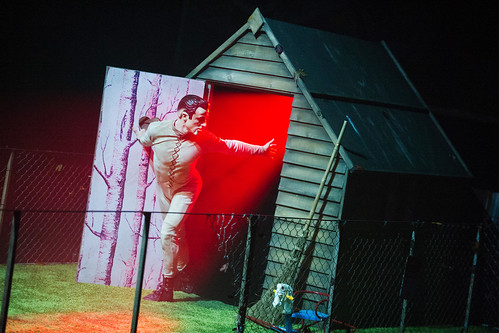 |
| Hansel and Gretel © ROH / Tristram Kenton |
2. The Linbury is home to some very experimental works. It's not just in choreography, music and stage design that the boundraries are pushed - the audience's emotional boundaries are put to the test too. Blood, Hansel and Gretel and the Metamorphosis are some of the most disturbing things I've seen in dance, and it was brilliant!
3. The Linbury hosts wonderful touring companies. This season I saw Ballet Black and the Northern Ballet. Next season, I am looking forward to the Ballet Boyz and the Rambert Dance company. It's an excellent opportunity to expand your dance horizon.
 |
| Yuhui Choe and Kenta Kura in The Human Edge. © Foteini Christofilopoulou |
4. My favourit Linbury works are the ones for which choreographers are commissioned to collaobarate with dancers of the Royal Ballet. It's a wonderful opportunity to see them up close and doing something different. Last week I saw Mayuri Boonham's The Human Edge, created for Royal Ballet's Yuhui Choe and Kenta Kura. It was stunning!
5. Finally, once a year, the Linbury stages "Draft Works", in which dancers from
within the ranks of the Royal Ballet create and perform their own work. It's so interesting ot see what the dancers come up with!
Tuesday, 6 May 2014
The Sleeping Beauty vs The Winter's Tale
A recent article in the Guardian discusses whether the classic ballets, like Swan Lake, should be retired in favour of a more contemporary repertoire. My last two visits to the Royal Opera House helped shape my opinion.
In March and April, I saw two ballets at the Royal Opera House: The Sleeping Beauty, a classic, and The Winter's Tale, a brand new production. Both are programmatic ballets which follow a traditional three act format; both are love stories with happy endings; and both draw from the classical repertoire of ballet steps. Yet one left me feeling that ballet is a dated art form, while the other felt completely contemporary and relevant.
 |
| in The Winter's Tale Alice Pennefather |
 |
| Sarah Lamb and Steven McRae in The Skeeping Beauty Johan Persson |
 |
| Sarah Lamb and Steven McRae in The Winter's Tale Johan Persson |
In a fantastic interview on BBC's Hardtalk, Tamara Rojo recently defended the classic ballets by arguing that "these classical ballets are the first step into our art form for most people". While I do not want to dispute Rojo's point (she really knows her stuff!), my guess is that the first-time ballet goers who saw The Winter's Tale, rather than The Sleeping Beauty, are the ones who are more likely to come back!
Wednesday, 26 March 2014
Jenni's Guide to Attending a Royal Ballet Performance - Part 2
If you plan to attend a performance at the Royal Opera House for the first time, here is some practical advice:
1. There is no dress code. The way people dress is quite mixed, from jeans to suits and pretty dresses. However, people rarely dress in black tie and ball gowns. You can't go wrong with smart casual.
2. Arrive at least half an hour before the performance begins. This will give you plenty of time to check your coats, pre-order drinks for the interval, etc.
3. Check your coat/umbrella/extra bags at the cloak room! It's free and you'll be much more comfortable in your seat.
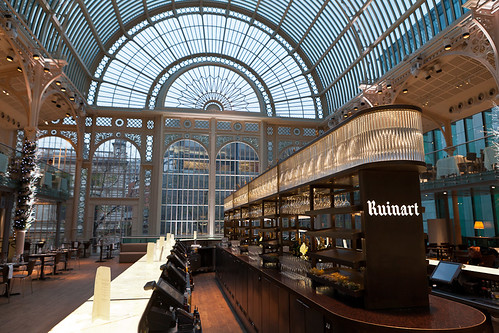 |
| The Paul Hamlyn Bar |
5. Programmes cost £6 and can be bought from in the main entrance foyer, the Paul Hamlyn Hall and the Amphitheatre lobby. Cast sheets are free.
6. Check out the view of Covent Garden Market from the roof terrace! The roof terrace can be accessed on most evenings from the amphitheatre bar on the top floor. From the terrace you can also peek into the windows of the costume workshops!
7. Don't miss the exhibition! In the foyer and along corridors are exhibited costumes and photos from past productions well worth checking out.
Thursday, 20 March 2014
Five Reasons to Attend a ROH Live Cinema Screening
 While nothing beats being there, here are a few reasons why ROH's live cinema screenings are worthwhile:
While nothing beats being there, here are a few reasons why ROH's live cinema screenings are worthwhile:
1. You have the best view (at the price of a cinema ticket). Even with the best seats in the house, you will never get to see the dancers this close up. It's very emotional.
2. You get to sit in comfortable seats and eat popcorn.
3. The backstage camera lets you see the dancers getting ready just before the curtain goes up.
4. During the interval, you can watch insight clips which include interviews with the cast and the making of videos.
5. With the help of Twitter you can connect with people all around the world sharing the same experience.
Also note that it's not just the Royal Opera House that does live screenings. Amongst others, the National Theatre and the New York Metropolitan Opera do live screenings too. Check your local cinema for information!
Tuesday, 11 March 2014
Ballet Dancers in Music Videos
Today, I found this great article on the Royal Ballet website discussing ballet in pop. And below are a couple of more contemporary examples featuring Royal Ballet dancers, Edward Watson and Elizabeth Harrod.
Elizabeth Harrod in Keaton Henson's "To Your Health"
And here's one more, featuring Alessandra Ferri of the American Ballet Theatre:
Alessandra Ferri and Sting: 'Prelude' from
"Cello Suite No. 1 in G major" by JS Bach
Monday, 10 March 2014
Jenni's Guide to Attending a Royal Ballet Performance - Part 1: How to Get Reasonably Priced Tickets
If you have never attended the Royal Ballet because you have been put off by the ticket prices, here is some advice on how to get reasonably priced tickets!
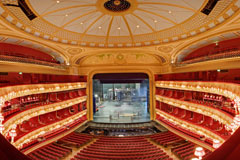 |
| Royal Opera House auditorium |
2. If you have three friends, get a balcony box for £32 per person! You must purchase the whole box which seats four. Boxes are located at the ends of the balcony circle, so the view is restricted (you cannot see the back corner of the stage on the side you are sitting on). On the other hand, you will be sitting close enough to the stage to make out the dancers' face expressions and get the full emotional impact of the performance.
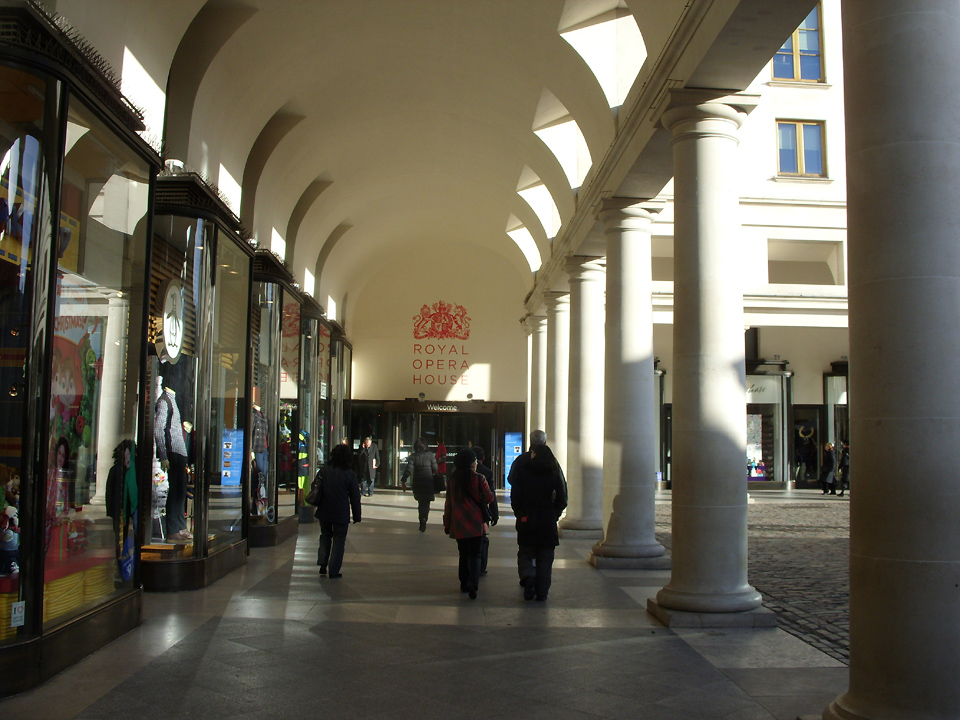 |
| Entrance to ROH from Covent Garden Piazza |
4. Try the Linbury Studio Theatre. This is ROH's smaller stage located in the basement. The Linbury Studio theatre often hosts smaller visiting companies (this season include Ballet Black and the Northern Ballet), but also more experimental works with members from the Royal Ballet (for example Hansel and Gretel and Draft Works). Tickets for performances here tend to cost no more than £25 and because it is a smaller venue, no matter where you sit, you get a good view.
5. Finally, if you're a student, you can sign up for ROH's student standby scheme to get £10 standby tickets. However, opportunities don't seem to come around that often, and when they do, you have to be incredibly quick.
Wednesday, 5 March 2014
Lunch with the FT: Edward Watson
Ok, it's a few years out of date, but this is the most interesting portrait of Ed Watson I've read in a while: Lunch with the FT: Edward Watson Still worth a read!
Monday, 24 February 2014
Divertissements (The Sleeping Beauty)
Classical ballets (think The Sleeping Beauty, Cinderella, The Nutcracker) are not my favourite. This is because with most classical ballets the plot is covered pretty quickly, so to create a full length performance, they need to be padded out with extra bits of dancing. Usually this is done in a party scene, where various guests perform solos and group dances (called "pas-de-insert-french-number"). These scenes always irritate me a little, as they seem really random, especially when the guests are cats or suits of cards... Often these scenes occur at the very end of a ballet when the story is basically over and one could leave feeling satisfied but instead is forced to sit for another half hour while the performance drags on... (At least with classical ballets like Swan Lake and Giselle the party scenes are at the beginning and so end on a dramatic high). But this article from the Royal Ballet website sheds some light on these so-called divertissements, which has made me reconsider their value. So I am looking forward to seeing the Royal Ballet's The Sleeping Beauty in the cinema on March 19th!
Wednesday, 19 February 2014
Tetractys - The Art of Fugue, February 15th, 2014, ROH
I went into Wayne McGregor's latest piece, Tetractys - the Art of Fugue - feeling rather confused. I'd planned to do some light background reading in preparation for this performance. This reading turned out to be a lot more difficult that I expected...
As the subtitle suggests, Tetractys is based on Bach's The Art of Fugue. Composed in the last decade of his life, it is considered by many to be Bach's greatest achievement. Consisting of 14 fugues, it is an extremely complex piece of counterpoint, mirror counterpoint and retrograde counterpoints (and if you want to learn more about this, Radio 3's Early Music Show recently did a really interesting program about it).
But McGregor dug deeper, unearthing theories concerning geometry, numerology, and the Pythagorean theory of numbers. This is where the idea of the tetractys comes in. A tetractys is a triangular figure consisting of ten points arranged in four rows like a pyramid. It is a mystical symbol that was important in the secret worship of the Pythagoreans. It represents unity, power, harmony and kosmos. This is about where I started to get lost...
 |
| A tetractys |
 |
| Natalia Osipova and Edward Watson |
| ©ROH/Johan Persson |
 |
| Paul Kay, Steven McRae and Sarah Lamb © ROH / Johan Persson 2014 |
Friday, 7 February 2014
Ballet, Sweat and Tears - A Documentary about the Mariinsky Ballet
Today I found this documentary about the Mariinsky Ballet. It really shows how tough being a ballet dancer can be!
What do Royal Ballet Dancers do on their Summer Break?
If you ever wondered what ballet dancers get up to over the summer break, this article is for you!
Wednesday, 29 January 2014
Two very different Giselles, January 20th and 27th, 2014, ROH
I saw two performances of Giselle this season. The first, on January 20th, saw Sarah Lamb make her debut in the role, with Steven McRae (also new to the role) stepping in last minute to replace Rupert Pennefather as Albrecht. The second, on January 27th at a live cinema screening, featured the much talked about partnership of Natalia Osipova and Carlos Acosta. It was the first time I had the opportunity to see the same production twice in one season. The differences between the two were striking.
In Act I, Lamb danced a sweet Giselle. She is easy to like, and I'm convinced that Albrecht, like the audience, can't help falling at least little bit in love with her. She seems genuinely naive, and it is not hard to understand her complete shock when she learns of his betrayal. Osipova, on the other hand, is a more complicated Giselle. There seem to be a number of things on her mind: her passion for dancing, her weak heart, her worried mother. Her dancing is sublime, of course. However, at times it felt like these things were more important to her than Albrecht.
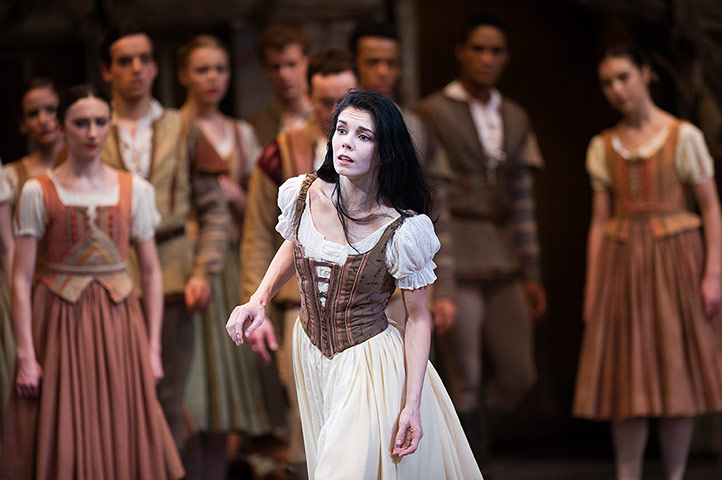 |
| Nathalia Osipova as Giselle Photograph: Tristram Kenton for the Guardian |
Steven McRae as Albrecht is utterly convincing. Initially, we perceive him as a young guy looking to have some fun, possibly to escape the dreariness of court life (he is engaged to the snooty Bathilde - brilliantly played both by Nathalie Harrison and Christina Arestis). However, his growing affection for Giselle is sincere, and when she dies his grief is genuine. McRae portrays the emotional complexity of this poignant moment with such subtlety that we are left reeling.
Acosta is not so convincing. His Albrecht is more regal, arrogant, and it is harder to sympathize with him. He does not seem to genuinely fall for Giselle, his grief is not authentic.
In Act II, both Claudia Dean and Hikaru Kobayshi are impressive in the role of Queen of the Wilis. Claudia Dean, "only" an artist, already awed us earlier in the season as the Chosen Maiden in The Rite of Spring. She is definitely someone to watch!
Osipova's Giselle is a bit harsh (her muscular arms and rather big, floppy hands do not help here); Acosta's Albrecht a little self-indulgent. At one point, forced to dance by the Wilis, he collapses with exhaustion, only to rise again with a flourish of his hand and look on his face that clearly expects applause (though, I must admit, he gets it). Lamb and McRae, on the other hand, are perfect together. I greatly look forward to seeing them together again in the upcoming production of Sleeping Beauty.
In Act II, both Claudia Dean and Hikaru Kobayshi are impressive in the role of Queen of the Wilis. Claudia Dean, "only" an artist, already awed us earlier in the season as the Chosen Maiden in The Rite of Spring. She is definitely someone to watch!
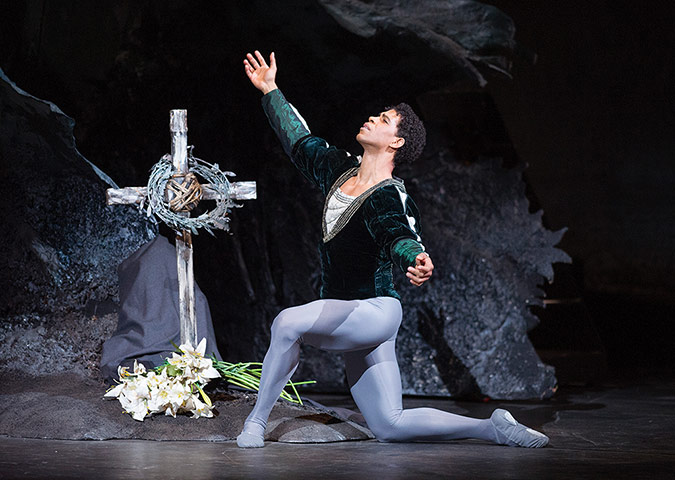 |
| Carlos Acosta as Albrecht Photograph: Tristram Kenton for the Guardian |
While the hype around Natalia Osipova is by no means unjustified, I think it a shame that Sarah Lamb is receiving so little attention for her beautiful performance (I have yet to read a review in the papers AND no one seems to have taken any photographs!). Her Giselle is the one that continues to haunt me.
Sunday, 26 January 2014
A day in the life: Romany Pajdak, Royal Ballet Dancer
If you've ever wondered what the typical schedule of a ballet dancer is like, this interview with Romany Pajdak is for you!
Hansel and Gretel, January 24th, 2014, ROH
As I make my way down the stairs into the Linbury Studio Theatre, I feel as if I am descending into another world - a much darker world. Following a path lined with bark, I make my way around the back of a creaky wooden hut, past a billboard with the ominous inscription "If you go down to the woods tonight..." and take my seat at the edge of the stage.
The stage, not so much a stage as a space either side of which the audience sit, is set to resemble a 1950s American home fully equipped with an enormous fridge and a wood-veneered television box from which are playing wholesome, black-and-white commercials about baking products. At closer inspection, however, it becomes clear that things are not as perfect as they seem. The family who live here are in the process of packing up their shabby-looking belongings, a realtor sign outside reads "For sale - desperate", trash spills across the floor, an empty bottle of beer stands in the corner.
 |
| James Hay and Leanne Cope in Hansel and Gretel © ROH / Tristram Kenton 2013 |
Enter Hansel (James Hay) and his Teddy bear. Hansel is everything you imagine a little boy to be: innocent, curious, loud and totally annoying. If he is not the center of attention, his teddy is.
And then the stepmother arrives. We hear her before we see her, her heels crunching over broken glass. She (Laura Morera) saunters in smoking a cigarette and looking extremely pleased with herself. However, her mood quickly changes when she discovers the bills is the postbox. In a brilliantly choreographed scene, she has a violent argument with her husband, during the course of which she slams his hand in the fridge door and breaks a bottle over his head. Gretel steps in to protect her father, and the stepmother turns on her, at which point the father finally loses it and punches his wife in the face. She storms out of the house, he follows, the children run to their room crying.
And then the stepmother arrives. We hear her before we see her, her heels crunching over broken glass. She (Laura Morera) saunters in smoking a cigarette and looking extremely pleased with herself. However, her mood quickly changes when she discovers the bills is the postbox. In a brilliantly choreographed scene, she has a violent argument with her husband, during the course of which she slams his hand in the fridge door and breaks a bottle over his head. Gretel steps in to protect her father, and the stepmother turns on her, at which point the father finally loses it and punches his wife in the face. She storms out of the house, he follows, the children run to their room crying.
 |
| Steven McRae as The Sandman in Hansel and Gretel © ROH / Tristram Kenton 2013 |
Hansel, hearing sounds, goes into the kitchen to find the sandman there. He approaches him with naive curiosity and tries to get him to join in a game with his teddy bear. The sandman lures him outside and into the woods. Gretel, realizing her brother is missing, runs after him. She finds him in the woods, alone. They get into an argument that ends in the teddy's head being ripped from his body. And then the children realize they are lost. In a twisted reference to the Grimm's fairy tail, they use stuffing from the teddy's body to mark their path. And so they reach the wooden hut and go inside. The sandman, emerging from the darkness follows them inside.
 |
| Brian Maloney as The Witch in Hansel and Gretel © ROH / Tristram Kenton 2013 |
When Hansel and Gretel burst into the room, the witch initially reacts with trepidation. However, encouraged by the sandman's whispers in his ear, he soon takes a liking towards Hansel, a liking he expresses in an alarmingly suggestive dance with him. Realization dawns on the children, but of course it is too late. What follows are disturbing scenes of violence and abuse. A particularly wicked scene has Hansel tied to a chair, while the witch pours a bin load of teddies over his head.
Eventually, however, the children do manage to escape. But there is no happily ever after, for they return home only to find that the house has been sold and the parents have left. In a final sinister twist, we see the children, left to their own devices, become their parents. It is a dark reminder that what we have just witnessed might be more than just fairy tale.
Subscribe to:
Posts (Atom)
